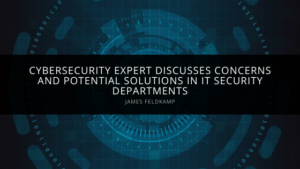Cybersecurity Expert James Feldkamp Discusses Concerns and Potential Solutions in IT Security Departments


Having worked in cybersecurity during both his military career and his professional career with the Federal government, James Feldkamp has developed a thorough understanding of present concerns, threats, and solutions in information security. Below, he shares how certain businesses are enhancing their IT departments to safeguard their company from attack.
James Feldkamp’s career stretches back three decades with much of it spent working on high-level security projects for the Federal government. An expert in cybersecurity, he often discusses pressing topics in information warfare and champions new initiatives to strengthen security measures in businesses and organizations across the country.
“Advances in technology during the past twenty years have provided countless benefits to businesses and corporations,” says James Feldkamp. “Today, they can make vital company decisions based on large sets of data analysis. Machines automate production in warehouses, and software and AI programs use digital means to improve processes across the board. Unfortunately, all this reliance upon these technologies has created new vulnerabilities, especially in information technology.”
Today, information security plays an essential role in the overall organization strategy of major businesses, and they must restructure their plans to focus on preventing data attacks to remain successful. One of the growing ways corporations are approaching this situation is by separating IT Security departments from the umbrella IT departments. Most times, this gives cybersecurity experts greater independence from leaders who may not understand present threats as clearly and more power to make decisions on their own judgement.
However, James Feldkamp warns that in order for the separated departments to succeed, they both need great communication between them. Among other things, this will help cybersecurity professionals keep informed of IT initiatives and continue making suggestions to better protect company data.
Regardless if the two departments remain one or not, Feldkamp says risk assessment and management should remain at the forefront of all business initiatives––especially in information departments. Doing so helps businesses find a balance between minimizing potential risks while exploring new solutions and opportunities. He suggests business leaders task their Chief Information Security Officers with calculating cybersecurity risks as well as participate in larger processes to share their insights.
One of the largest problems facing information security is a lack of qualified cybersecurity personnel and overly high expectations of candidates. Without new candidates filling in roles in information security, companies leave plenty of room for attack. Often, they expect their new hires to have an immediate effect on their processes, which requires high and select skills from candidates. On the other hand, companies may also fear hiring under-qualified or average candidates who may end up leaving after training for a better paying position.
“We need new solutions in information security, undoubtedly, but we also need a compromise between businesses and the expectations placed on new hires,” says James Feldkamp. “And I think we need stronger communication between departments in addition to more support from CISOs on top-level strategy initiatives.”





